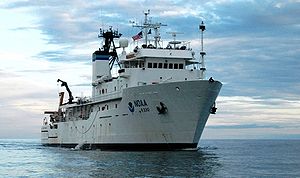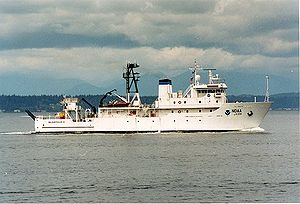NOAAS McArthur II (R 330)
 NOAAS McArthur II (R 330) sometime between 2003 and 2009 | |
| Career (United States) | |
|---|---|
| Name: | McArthur II |
| Namesake: | William Pope McArthur (1814-1850), a United States Coast Survey officer who pioneered hydrographic survey work on the United States West Coast |
| Builder: | Tacoma Boatbuilding Company, Tacoma, Washington |
| Laid down: | 26 January 1985 |
| Launched: | 16 July 1985 |
| Completed: | 26 November 1985 |
| Acquired: | 9 December 2002 |
| Commissioned: | 20 May 2003 |
| Homeport: | Seattle, Washington |
| Nickname: | "Big Mac"[1] |
| Status: | Active in NOAA Pacific Fleet |
| Notes: | Served in U.S. Navy Military Sealift Command as ocean surveillance ship USNS Indomitable (T-AGOS-7) 1985-2002 |
| General characteristics | |
| Type: | ex-U.S. Navy Stalwart-class oceanographic research ship |
| Tonnage: | 1,486 gross register tons; 786 deadweight tons |
| Displacement: |
1,650 tons (light) 2,301 tons (full load) |
| Length: | 224 ft (68 m) |
| Beam: | 43 ft (13 m) |
| Draft: | 15 ft (4.6 m) |
| Installed power: | 1,600 horsepower (2.1 megawatts) |
| Propulsion: | Diesel-electric: Two General Electric 800-horsepower (1.1-megawatt) diesel engines, twin fixed-pitch propellers, 224,000 gallons fuel; 550-horsepower (0.74-megawatt) General Electric Harbor Master bow thruster |
| Speed: | 10.5 to 11 knots (sustained)[2] |
| Range: | 8,000 nautical miles (14,816 kilometers) |
| Endurance: | 30 or 45 days[3] |
| Boats and landing craft carried: | One 24-foot (7.3-meter) Zodiac rigid-hulled inflatable boat (RHIB); one 21-foot (6.4-meter) Zodiac RHIB |
| Complement: | Either 22 (5 officers, 4 licensed engineers, and 13 other crew) or 24 (4 officers, 3 licensed engineers, and 17 other crew)[4] plus up to either 15 scientists on domestic voyages or up to 14 scientists plus a Public Health Service during international voyages; or 21 (5 officers, 3 licensed engineers, and 13 other crew, plus 10 to 15 scientists[5] |
| Sensors and processing systems: | One Furuno X-band radar, one Furuno S-band radar, both for navigation and collision avoidance; two depth sounders; a Furino Automated Identification System; several Global Positioning System receivers; Speery MK227 gyrocompass |
| Notes: | 600 kilowatts electrical power; 250-kilowatt emergency generator |
NOAAS McArthur II (R 330)[6] is an oceanographic research ship in National Oceanic and Atmospheric Administration (NOAA) service since 2003.
Contents
Construction, acquisition, and commissioning
McArthur II was laid down as the United States Navy Military Sealift Command Stalwart-class ocean surveillance ship USNS Indomitable (T-AGOS-7) on 26 January 1985 by the Tacoma Boatbuilding Company at Tacoma, Washington, and launched on 16 July 1985. Indomitable entered service on 1 December 1985 and was retired and stricken from the Naval Vessel Register on 2 December 2002.
On 9 December 2002, Indomitable was transferred to NOAA. After conversion into an oceanographic research ship, she was commissioned into NOAA service as NOAAS McArthur II (R 330) at the NOAA Marine Operations Center at Seattle, Washington, on 20 May 2003, replacing the NOAA survey ship NOAAS McArthur (S 330), which was decommissioned in a combined ceremony the same day.
Capabilities
McArthur II has berthing for 38 people in 18 single staterooms, eight double staterooms, and one quadruple stateroom, providing her with the capacity to carry up to 15 scientists on domestic voyages or up to 14 scientists and a Public Health Service officer on international voyages. She can seat 16 people at a time in her crew's mess.
McArthur II has a wet laboratory freezer, a dry laboratory freezer, and an oceanographic laboratory refrigerator. On deck, she has a 2.3-ton-capacity deck crane with a boom that extends to 46 feet (14 meters), two oceanographic winches, a movable A-frame, and a movable J-frame. She carries one 24-foot (7.3-meter) and one 21-foot (6.4-meter) Zodiac rigid-hulled inflatable boats (RHIB).
Career
McArthur II departed on her maiden NOAA cruise on 1 June 2003 from Seattle. She conducts oceanographic research and assessments, throughout the eastern Pacific Ocean, including along the United States West Coast -- where is involved in studies in several National Marine Sanctuaries -- and the Pacific coast of Central America and South America. She engages in measurements of chemical, meteorological, and biological sampling for several large scale programs within NOAA, and the scientists who carry out research aboard her come from many divisions of NOAA, as well as other United States Government agencies, U.S. state government agencies, and academia.
Notes
- ↑ NOAA Ship McArthur II / R-330 Welcome aboard Packet - noaa.gov - Retrieved December 27, 2007
- ↑ These two cruising speeds are on the same page of the ship's home page at NOAA Marine Operations NOAAS McArthur II General Specifications (at http://www.moc.noaa.gov/mt/specs/general.htm).
- ↑ These two endurance figures are given on the same page of the ship's home page at NOAA Marine Operations NOAAS McArthur II General Specifications (at http://www.moc.noaa.gov/mt/specs/general.htm).
- ↑ These complement numbers represent two contradictory sets of figures on the same page of the ship's home page at NOAA Marine Operations NOAAS McArthur II General Specifications (at http://www.moc.noaa.gov/mt/specs/general.htm).
- ↑ Per Combat Fleets of the World 15th Edition, p. 1006.
- ↑ Combat Fleets of the World, 15th Edition, p. 1006, claims that the ship's hull code is R 337, but a photograph at the ship's NOAA Marine operations home page (at http://www.moc.noaa.gov/mt/index.html) clearly shows "R 330" painted on her hull. NavSource Online (at http://www.navsource.org/archives/09/66/6607.htm) gives her the hull number R 334, but a photograph of her at the same Web page also shows "R 330" on her hull.
References
- NOAA Marine Operations NOAA Ship McArthur II
- Wertheim, Eric, ed. The Naval Institute Guide to Combat Fleets of the World, 15th Edition: Their Ships, Aircraft, and Systems. Annapolis, Maryland: United States Naval Institute Press, 2007. ISBN 978-1-59114-955-2. ISSN 1057-4581.
| ||||||||

